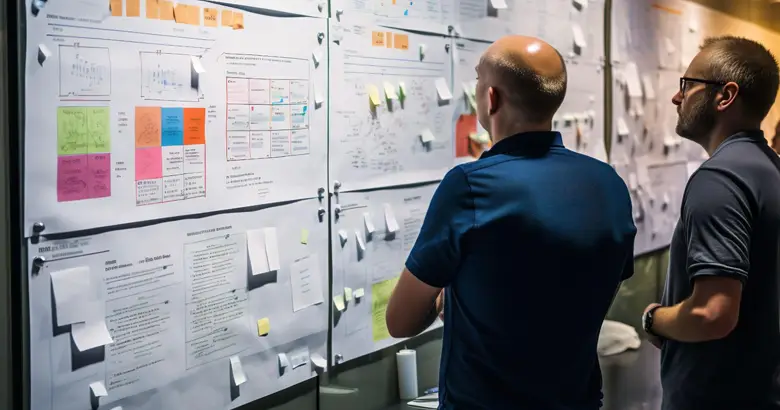Design thinking is a problem-solving methodology that actively addresses user-centric challenges. Learn how industry leaders implement this concept through our compilation of real-life design thinking examples.
Design thinking has risen as an influential methodology for problem-solving that actively employs empathy, brainstorming, and testing to produce novel solutions. However, contrary to popular belief, this methodology is not just a handy tool for designers and has found application in multiple different industries.
In this article, we explore some key examples and case studies where popular brands have implemented design thinking in the pursuit of finding solutions to complex challenges, as well as what you can learn from each. Here’s what we cover:
- How is Design Thinking Implemented?
- Nike
- Airbnb
- Netflix
- GE Healthcare
- UberEATS
- Oral B
- Project Bloks
- Is Design Thinking Intuitive?
How is Design Thinking Implemented?
The design thinking process is a systematic approach to problem-solving that follows a structured framework for producing novel solutions. The same is implemented through five distinct steps:
Empathise:
The first step of the design thinking process, empathize, is dedicated to gaining profound insights into the needs, desires, and challenges of the end users. The main goal at this point is to observe and collect user data without letting any preconceived notions hinder the process.
Define:
During the define step, all data collected is meticulously synthesized to formulate a precise problem statement. The goal is to refine and narrow down the scope of the problem into clear and concise statements by identifying recurring user patterns, discerning trends, and categorizing problem areas.
Ideate:
This is the point in the design process where most creativity, innovation, and solutions are birthed. The primary aim is to effectively address the identified problem statements and alleviate user pain points through solution-oriented interventions.
Prototype:
The prototype step is all about bringing ideas and solutions to life through experimentation. This is a particularly important step as it allows individuals to see the tangible impact of their solutions and focus on their functionality and effectiveness.
Test:
User feedback is paramount at this stage, as it significantly influences the design process. The testing step offers an invaluable opportunity to assess the ease of functioning, operational efficiency, and how effectively the solution tackles the problem statement.
To see these design thinking steps in action and understand how they come together in real-world scenarios, watch this quick video.
Since design thinking is inherently iterative, the steps in the process are not set in stone and often take a non-linear approach. For deeper insights into how each of these steps flesh out in practice, you can refer to this Parent Assistance Project by AND learner Shrikant Subramaniam.
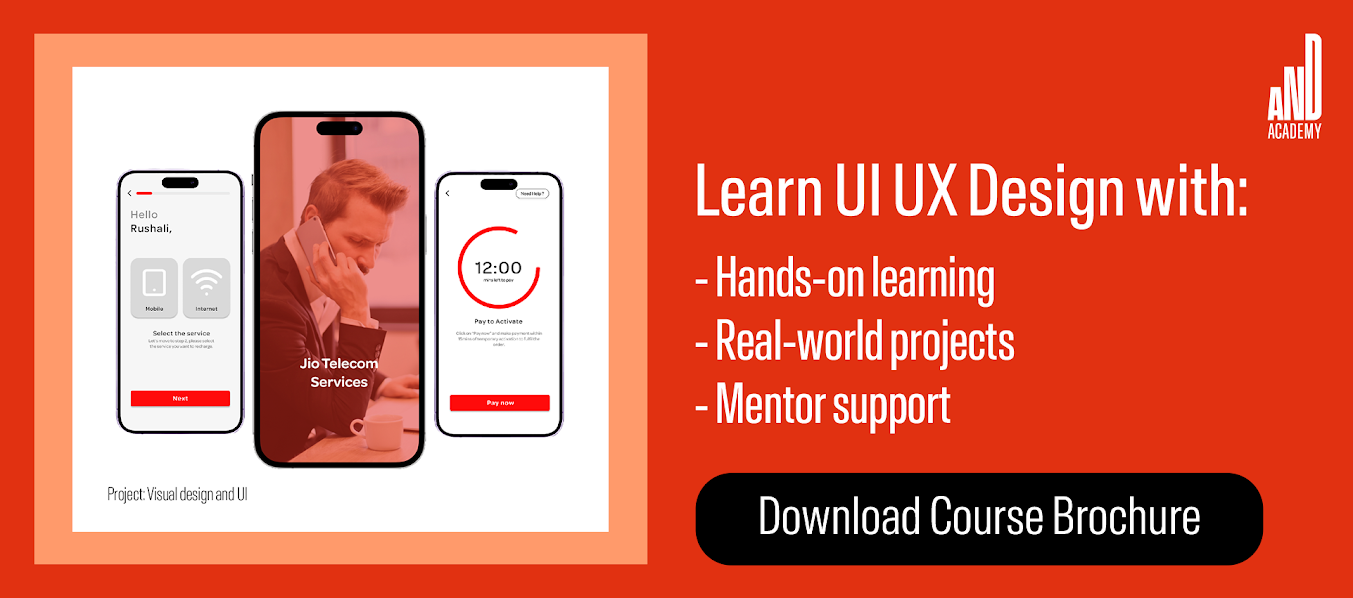
Examples of design thinking applications
Design thinking has been extensively used across industries and sectors to address common user and business problems. However, some monumental examples where major brand names employed design thinking to spearhead their growth are what we will cover.
1. Nike:
Renowned as a prominent influencer in the shoe design industry, Nike has maintained its status as a favorite among athletes for nearly five decades.
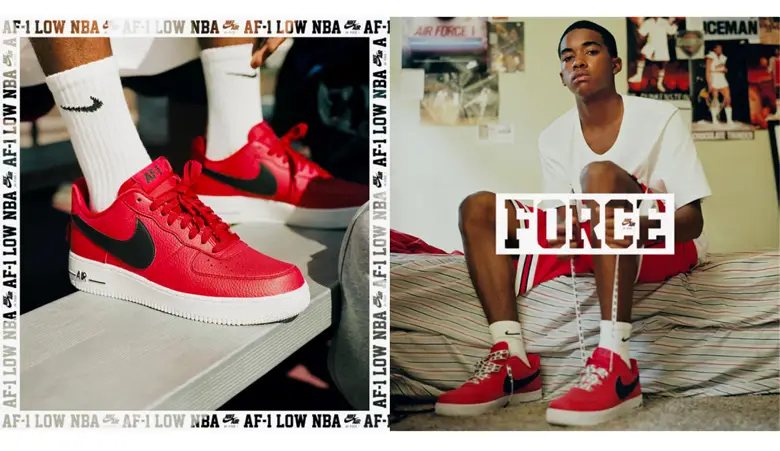
Image Courtesy: Nike
How they use design thinking
Nike’s design ideology of ‘moving forward’ has consistently focused on creating new, groundbreaking innovations. Here are a few design thinking strategies that the brand has consistently implemented in their process:
- Nike’s innovation is rooted in user needs. Since the brand caters to athletes, their products are not just sports gear but are rather developed to cater to questions of comfort and performance – a big factor when it comes to athletic prowess.
- Nike’s emphasis on user-centric design is also evident in their vast offering of designs and styles that are developed to cater to the cultural nuances of diverse groups at a global level.
- Nike’s design thinking approach also places a huge emphasis on prototyping without constraints. Their Flyknit Racer is an excellent example of dedication to prototyping considering the final design was achieved after 195 trials.
Application of Design Thinking by Nike
Nike’s Air Force One campaign, which established the brand as a leader in the sports fashion industry, utilized pressurized air technology. The product was developed keeping in mind not only what athletes needed in terms of performance, but also what they wanted in terms of style and comfort.
Another instance where Nike drove business decisions based on user needs was with its Nike Dunk SB line. Struggling to enter the skateboarding community, the brand involved skateboarders in the design process to understand what they were looking for in skateboarding footwear and, by extension, their perception of Nike. The Nike SB line of shoes saw great success and earned Nike a spot within the skateboarding community.
What you can learn from Nike
Nike has explored new ventures, but its primary target audience has always been athletes, with performance being at the core of all business and design decisions. The brand’s ability to understand and empathize with the needs of customers, combined with its flexibility towards prototyping and testing, has propelled them to success.
2. Airbnb:
Known as the pioneer of the experience economy, Airbnb today stands as a $75.4B company still dictating the fundamentals of user-friendly design. However, behind Airbnb’s massive success lies its approach to human-centric design.

Image Courtesy: Airbnb
How they use design thinking
When it comes to actively addressing user pain points, Airbnb has always focused on human-centric design. The biggest challenge for Airbnb has been to address the ‘absence of trust’ guests feel when booking a room. Some design thinking-based strategies came in quite handy in addressing these.
- The social bias against strangers was addressed through rampant user research that prioritized empathy. Airbnb’s decision to design a form suggesting an appropriate host message length and suggestive prompts was rooted in this research, which found a correlation between the message length and host acceptance rates.
- The UI UX design of the platform has been carefully designed to enhance user experience since it is the first brand touchpoint for users. Personalized recommendations, the incorporation of storytelling to foster an emotional connection, and the addition of detailed information and pictures are deliberate decisions that allow Airbnb to address the lack of trust among customers.
- The Airbnb office was also redesigned to resemble apartments. The idea was to allow employees to function in the environment that they were designing for, actualizing the importance of empathy and the role it plays in successful ideation.
Application of Design Thinking by Airbnb
While Airbnb has consistently applied design thinking principles, two notable case studies exemplify its commitment to this approach. First, when faced with the challenge of low registrations, Airbnb founders took a hands-on approach by personally visiting hosts in New York to assist them in uploading high-quality images of their properties. Despite being an unconventional and non-scalable decision, this initiative proved highly effective, doubling revenue by alleviating customer uncertainty regarding the accommodations they were considering.
Similarly, Airbnb adopts the ‘Patient Approach’ as part of its onboarding process for new employees. This involves sponsoring trips for employees during their first or second week to experience firsthand the customer’s journey. Employees are tasked with documenting their experiences and answering structured questions, fostering an environment of empathy-driven innovation within the company.
What you can learn from Airbnb
The essence of the design thinking process lies in empathy, a principle that Airbnb has fully embraced and mastered. From having employees experience a customer’s journey to making business decisions based on empathy, Airbnb’s success showcases the value of deviating from traditional approaches to address challenges. The company’s focus on testing new hypotheses for making long-term decisions has also contributed to its success.
3. Netflix
Credited for bringing in the phenomenon of ‘binge-watching’, Netflix has been known for keeping up with the changing market and producing customer-friendly solutions. The application of design thinking has undoubtedly helped this streaming giant maintain its position in the market.

Image Courtesy: Netflix
How they use design thinking
Netflix’s primary goals, ever since its inception, have been:
- To reduce user effort by elevating the overall experience.
- To utilize user data to adapt to the changing market needs
This approach has pioneered several customer-friendly innovations. Features like ‘Skip Intro’ or ‘Because you watched’ were developed after observing user behavior and have contributed to the platform’s unmatched experience.
The incorporation of video previews instead of still images or movie posters is one small change that significantly improved user experience. Similarly, the decision to create and stream original content that fit user tastes further enabled Netflix to strengthen its hold over the market.
Application of Design Thinking by Netflix
Netflix’s Shuffle button is a prime example of design thinking in practice. Recognizing that the vast array of choices on the platform sometimes overwhelms users, based on data from user research, Netflix effectively removed the burden of decision-making from the user’s shoulders.
Instead of spending precious time browsing through countless options, users can simply hit the Shuffle button and let Netflix curate a selection for them. This not only alleviates decision fatigue but also adds an element of surprise and spontaneity to the viewing process.
What you can learn from Netflix
Netflix constantly gathers user feedback and actively applies gathered data to the next iterative improvement. This constant cycle of feedback and testing based on the user’s changing needs is the core of design thinking and Netflix employs it seamlessly.
4. GE Healthcare
Founded in 1994, GE Healthcare is headquartered in Chicago, Illinois, and operates in more than 100 countries. It was through design thinking that the brand revamped the typically scary experience that children face when undergoing a scan.

Image Courtesy: GE Healthcare
How they use design thinking
The experience of undergoing a scan has often proven to be harrowing for young children. Identifying this as a potential pain point for the young audience, Doug Dietz, the chief designer at GE Healthcare identified two problem statements:
1- To reduce the anxiety children experience while undergoing a standard scan
2- To address the need for anaesthesiologists to help calm down children for a scan
Doug’s journey began with a keen desire to gain a deeper understanding of his target audience, much in line with the “empathize” step of the design thinking process. To achieve this, he took proactive steps such as actively observing children at a daycare center and engaging with child specialists to uncover the motivations and behaviors of young children.
Doug also organized a brainstorming session at a children’s museum, wherein the children participated and contributed by sketching out their ideas. Many of these later served as valuable inspiration for refining designs and prototypes.
Drawing from his extensive research findings, Doug developed what would become known as the ‘Adventure Series’, a groundbreaking pilot program implemented at the children’s hospital within the University of Pittsburgh Medical Center.
Application of Design Thinking by GE Healthcare
As per the ‘Adventure Series’, MRI machines were completely redesigned into captivating adventure environments. Each machine was decorated with distinct themes, such as pirate ships, black holes, beach scenes, and whimsical sandcastles to make the MRI experience enjoyable and engaging for young children. This not only alleviated the fears and anxieties associated with the procedure but also significantly reduced the children’s dependency on anesthesiologists for scans, bringing down overall expenses. In fact, the overall patient satisfaction rating went up to 90% after the intervention. [H4] What you can learn from GE Healthcare
GE Healthcare stands as one of the best examples of the application of the design thinking process. Right from Doug Dietz’s immersive user research to understand the needs of young children and empathizing with their fear right up to the multidisciplinary approach he undertook towards the problem statement, each step exemplifies the lasting impact design thinking can have if done right.
5. UberEats
UberEats stands out among other delivery services as one of the fastest-growing platforms. Unlike a retrospective approach, which focuses on refining existing models, UberEats opted for a forward-thinking strategy, emphasizing the importance of creativity and user-centric design from the outset.
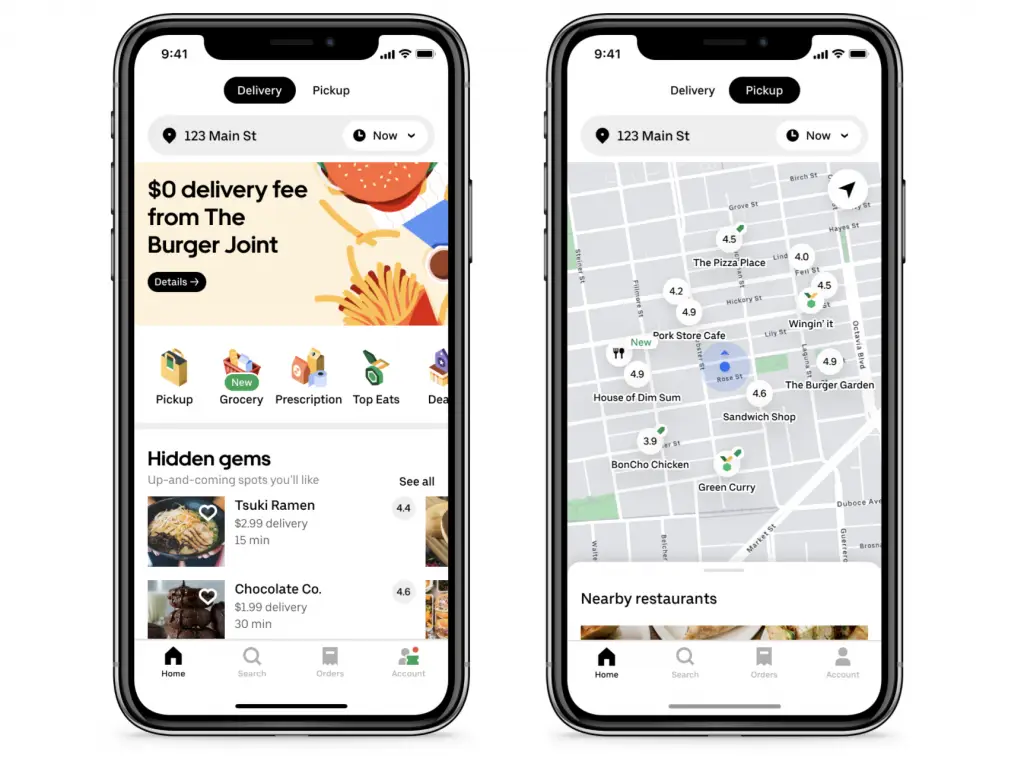
Image Courtesy: UberEats Newsletter
How they use design thinking
The design thinking approach that UberEats took concentrated primarily on three levels: empathizing, iteration, and testing.
At the empathizing level, UberEats designers conducted interviews with stakeholders at every touchpoint of the delivery process. This included delivery partners seeking to increase their earnings, restaurant owners interested in business expansion, and customers ordering food. To effectively empathize with each group, UberEATS launched three distinct programs operating at different levels:
- The Walkabout Program allowed employees to travel to different cities and learn key aspects like the culture of the city, and transportation system, and interview each stakeholder for first-hand information.
- Order Shadowing enabled designers to observe the app operation in person. Essentially, employees were asked to shadow delivery partners during their shifts, visit restaurants at peak hours, and observe how people interacted with the app to order food from home.
- Fireside Chats, was started as a program that encouraged all stakeholders to provide feedback on their experience. These were lightweight sessions that were put in place particularly to help designers actively empathize with the users and bridge any gaps between the Walkabout and Shadow programs.
Application of Design Thinking by UberEats
UberEats’ application features aim to optimize the experiences of all stakeholders. Notable functionalities include drivers’ ability to undertake rides and deliveries concurrently for increased income, a restaurant sales dashboard empowering chefs to refine dishes based on demand, and the ‘Under 30 Minutes’ service for swift deliveries. Additionally, user behavior insights led to the ‘Most Popular Item’ category being introduced for simplified ordering and a dedicated driver app facilitating efficient route planning by avoiding congested parking areas.
What you can learn from UberEats
UberEats stands as a valuable example of how incorporating design thinking into the strategic and planning levels can lead to long-term success. In the case of UberEats particularly, the emphasis on user research and empathizing helped the company accurately assess the needs and create solutions that addressed latent customer desires.
6. Oral B
Oral-B, a renowned brand in oral hygiene products, has consistently leveraged design thinking principles across its product development and innovation endeavors. Notably, one standout project showcasing the effective application of design thinking is the redesign of Oral-B’s children’s toothbrush.

Image Courtesy: IDEO
How they use design thinking
Oral-B’s Children’s Toothbrush exemplified a comprehensive integration of design thinking principles, from empathizing to testing. The initiative was driven by two key challenges:
- Creating a children’s toothbrush that transformed oral hygiene into an enjoyable experience for young users.
- Enhancing the toothbrush design to meet children’s needs and gain a competitive edge in the market.
To address these challenges, Oral B partnered with IDEO and conducted extensive observational research to comprehend children’s interactions with the product. Through this process, the design team observed that children tended to grasp the toothbrush with their palms rather than their fingers due to limited dexterity. This user insight led to the creation of a prototype solution named the “Squish Gripper.”
Application of Design Thinking by Oral B
The children’s toothbrush featured the “Squish Gripper”, a wider handle with a soft texture grip, facilitating easier handling for children. This aspect was crucial as many existing children’s toothbrushes on the market were essentially scaled-down versions of adult products, lacking consideration for a child’s grip strength. Subsequently, the prototype underwent testing with young users, who were observed while using the product. The team also incorporated vibrant colors and engaging graphics to appeal to children and make them look forward to brushing their teeth.
What you can learn from Oral B
Oral-B’s children’s toothbrush exemplifies the power of accurate observation in driving success. By delving into why children held the toothbrush with their palms instead of fingers, designers uncovered a gap between needs and market supply, paving the path to eventual success.
7. Project Bloks
Project Bloks was an experimental research project initiated by Google’s Creative Lab in collaboration with IDEO to explore tangible programming for kids. The experiment focused on making coding more accessible to young children who might not have access to digital devices or might find traditional programming methods too abstract.
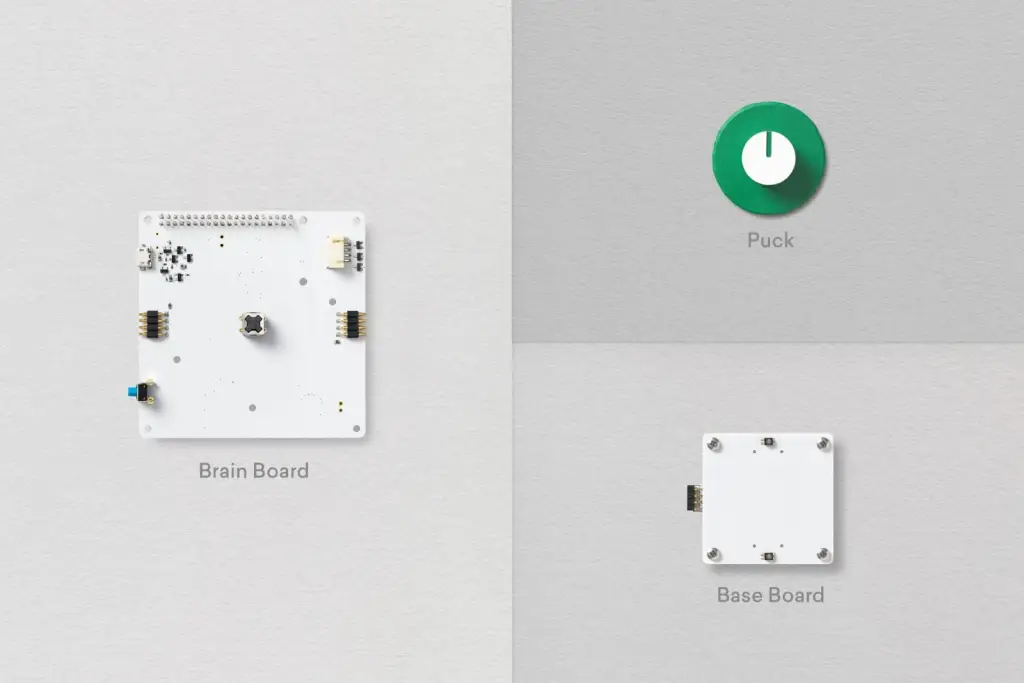
Image Courtesy: Google Research
How they use design thinking
The core idea behind Project Bloks was to create a system of physical, modular components that children could use to learn programming concepts in a hands-on, playful way. These components consisted of three main things:
- Pucks: These were small, programmable physical objects that represented different programming commands or actions, such as “turn left,” “move forward,” or “start/stop.” Each puck had a unique shape and color, making them easily recognizable and distinguishable.
- Base Boards: The baseboards were flat, circuit-board-like surfaces onto which the pucks could be attached and programmed.
- Brain Board: This was the central processing unit of the system, responsible for interpreting the commands programmed into the pucks and executing them. It connected to the baseboards and provided the computational power needed to run the programming logic.
To develop these three essential components the team at IDEO observed how children interacted with their environment. The research also included interacting with teachers and parents which helped narrow down three essential design principles that the product was supposed to incorporate: simplicity, modularity, and familiarity. The final product development stage took an iterative process where teams first made rough sketches and mockups that were tested before zeroing in on a final design.
Application of Design Thinking by Project Bloks
Project Bloks allowed children to arrange the pucks on the baseboards to create sequences of instructions. Children could activate it by pressing a play button, and the Brain Board would execute the instructions, allowing them to see the results of their code in action. By doing so, Project Bloks provided a physical, tangible interface that could be easily understood and manipulated by children of various ages and backgrounds.
What you can learn from Project Bloks
Project Bloks’ effectiveness stems from thorough empathetic research. Observations of children’s interactions informed a product that revolutionized programming for kids, simply by enhancing interactivity and user-friendliness.
Is Design Thinking Intuitive?
The iterative nature of design thinking often leads to the misconception that the process is inherently intuitive. This is especially apparent in activities like empathizing and brainstorming, which may seem subjective and instinctual. However, it’s crucial to understand that mastering design thinking requires dedicated time and effort. Even fundamental principles such as empathy and brainstorming necessitate a structured approach to effectively filter out a designer’s preconceptions and biases. Tools like empathy mapping, journey maps, and persona creation serve as essential aids in this regard.
For individuals more accustomed to linear, analytical problem-solving approaches, the open-ended nature of design thinking can present unique challenges. In such cases, seeking professional guidance through a formal design thinking course can be the most effective way to adopt the required mindset. Consider reading this blog that curates a list of the best design thinking courses to help you choose the best one.
Next Steps
We hope this comprehensive guide to design thinking examples could throw light on what this problem-solving methodology can do. If you are particularly interested in learning design thinking in the context of user experience, here are some related resources that you might find useful:
Here are some related resources that you might find useful:
- Watch this session by Shiva Viswanathan, Design Head of Ogilvy Pennywise, and Naman Singh, Product Experience Designer at RED.
- Talk to a course advisor to discuss how you can transform your career with one of our courses.
- Pursue our UI UX Design courses – all courses are taught through live, interactive classes by industry experts, and some even offer a Job Guarantee.
- Take advantage of our scholarship and funding options to overcome any financial hurdle on the path of your career transformation.
Note: All information and/or data from external sources is believed to be accurate as of the date of publication.

